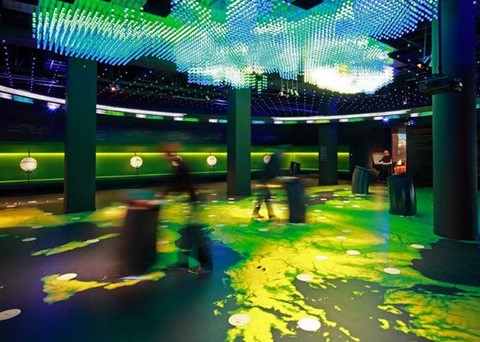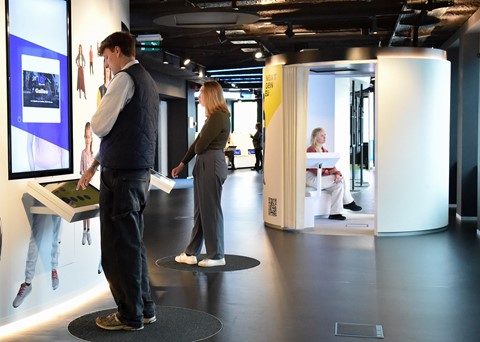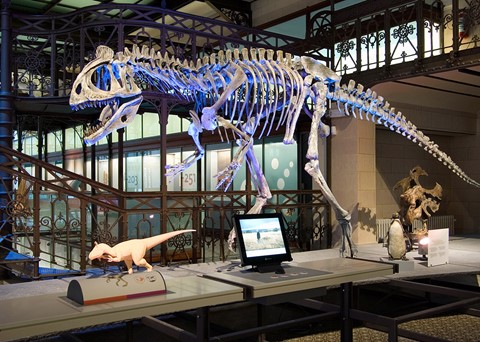House of European History
Entrance is free, with audio-guides in the 24 official languages of the European Union.
At the heart of the House of European History, the permanent exhibition galleries use objects, reconstructions and multimedia resources to take visitors on a thought-provoking narrative that focuses on the continent’s 19th and 20th centuries.
The museum regularly hosts temporary exhibitions.
For example, exploring the issue of waste in Europe, disinformation or artwork during wartime. Discover the current temporary exhibition on the website.
Teachers and Students
Learning aids and resources are available both on-site and online. There are downloadable teachers’ notes, class and group activities, along with photographs, written testimonies and videos. These materials can be easily adapted to use with curriculum content.
Families
For families with 6-10 year olds - take a backpack and 'time-travel’ through different periods of Europe’s past! Kids will smell, feel and live history as never before, through role-play games in a 1960s Travel Agency, walking in the shoes of an astronaut or grappling with robots.
Family Spaces are available in 24 languages and accessible during opening hours of the museum. Extra facilitated learning activities are on Wednesdays, Saturdays and Sundays at 14:00 to 17:00. Entrance is free. No reservation required.
The museum is family-friendly, with baby-changing facilities and access for buggies. Parents may feel certain aspects of the permanent exhibition are only suitable for children over eleven years old.

- Monday : -
- Tuesday : -
- Wednesday : -
- Thursday : -
- Friday : -
- Saturday : -
- Sunday : -
- T. +32 2 283 12 20
- Rue Belliard 135 Belliardstraat - 1000 Brussels
- https://historia-europa.ep.eu/
- historia@europarl.europa.eu
-
Opening times
29/03/2025 - 11/01/2026: * monday: from 13:00 to 18:00 * tuesday, wednesday, thursday and friday: from 09:00 to 18:00 * saturday and sunday: from 10:00 to 18:00
Far from being confined to museums or books, history plays a significant role in everyone's lives: visits to places that have become tourist sites, commemorations and re-enactments of events, excavations, conservation or collections of ancient objects. Interactions with the past can take many forms, and have a variety of purposes, such as ensuring links within a community, building identity, having fun or remembering certain tragedies of the past. In order to evoke all these links that the people living in Europe can have with history, the exhibition ‘Presence of the Past. A European Album’ is divided into seven main sections: The tourist appeal of historic sites, places of pilgrimage that are sometimes enjoyed simply to fill up our social networks. Commemorations which, in today's post-heroic era, highlight soldiers and civilian victims in rituals of remembrance or appeasement, without focusing solely on military leaders. Historical re-enactments, which have been practised for decades but have recently been gaining in popularity. The manufacture of heroes, to examine the mechanisms at work in creating cults of personality, sometimes spontaneous, sometimes imposed by the state. De-commemoration, to assess possible solutions to monuments inherited from bygone eras, such as those associated with colonisation, slavery or dictatorial regimes. The past as landscape, when nature gradually reclaims places marked by tragic histories. And the historians of everyday life, those citizens who go in search of old objects, collecting them or exhibiting them to anchor themselves in the past of their family, country or community. For this exhibition, the House of European History is partnering with Brussels-based Atelier de photographie de l'École nationale supérieure des arts visuels de La Cambre. Six of the 21 photographers whose work will be presented have studied at this college, and will thus showcase the younger generation’s take on how history permeates our daily lives. Visitors are encouraged to explore the historian in them through interactive activities in the exhibition.
-
Opening times
27/06/2025 - 31/10/2025: * monday: from 13:00 to 18:00 * tuesday, wednesday, thursday, friday, saturday and sunday: from 10:00 to 18:00
Presented in an audio-visual setting which recreates the atmosphere of the city, from its metro, parks, and people’s homes, the stories told in “Raising our roots” contrast European history as shown in the museum, with intimate realities from Brussels and narratives on migration throughout time. Visitors will experience the in-between-ness of the ever-changing city that is Brussels. The participatory process The members of the Echoes collective - selected through a call for application - were invited to work together in a year-long project. They identified unheard voices and missing narratives in history, and developed a particular interest in changing the way migration histories are told. The Echoes participants then searched the streets and houses of Brussels for untold stories and personal accounts of migration and belonging. They transformed these stories into audio-visual content, which amplifies voices of history and of Brussels alike, raising their roots into the light.
Slow Looking Saturday is a museum series taking place during the temporary exhibition ‘Presence of the Past – a Photo Album’. Every first Saturday of the month at 14:30, come and delve into a topic of the exhibition through specific photographs for an hour. A facilitator will accompany you and the group to look at a photograph at a different pace and take the time to reflect on it. Collectively the sessions will cover all the rooms in the exhibition, through the slow looking practice and learning of historical facts based on the group’s observations and reflections. Please register in advance for the session you want to attend, to secure your spot and get a reminder before the event. Registered visitors will have priority, but you can also drop by the museum and see if spots are available on the day. To ensure a pleasant experience, the ideal group size is about 15 people . If not registered in advance, the “first come, first served” rule will be applied. Slow Looking Saturday calendar 5 July – Destination: History Focus on ‘Mediterranean. The Continuity of Man’ by Nick Hannes – a look to the - sometimes troubling - tourist behaviours in heritage sites. 2 August – De-commemoration Focus on ‘Washing Away the Past’ by Ria Pacquée – which traces the cleaning of a monument of Leopold II in Oostende, Belgium, that activists had doused with red paint. 6 September – Re-enactments Focus on ‘Nostalgia for Mud’ by Hugo Passarello Luna – a contemporary look through a World War One camera at re-enactment events. 4 October – The past as landscape Focus on ‘The Last Stand’ by Marc Wilson – a highlight on the physical remnants of the war in nature. 1 November - Museum closed, no Slow Looking Saturday taking place. 6 December – Let’s make history! Focus on the sets of pictures available in the “Let’s make history!” exhibition interactive – this session draws links with the rest of the exhibition and records details that could vanish soon! Practical information - Meet the guide at 14:30 in the Fables Room, just before the entrance of the temporary exhibition. - Please be aware that to enter the museum, you would pass through security checks which can take some time. - Please arrive 10 minutes in advance. The activity will be held in English. - The activity is suitable for people aged 16 years old and over. - Registration is recommended in advance.









